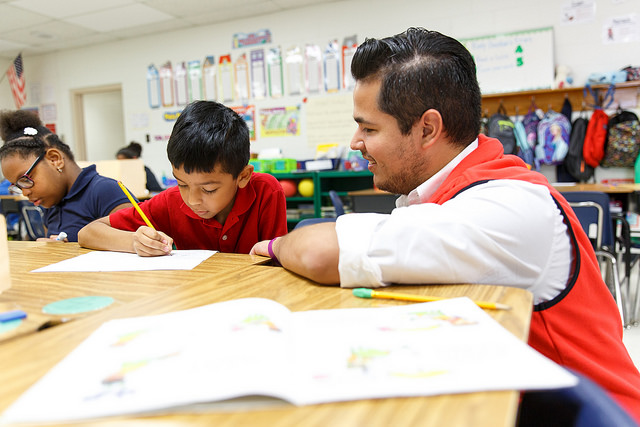
Every day social innovators and social innovation organizations across the country are measurably impacting communities and individuals. This Practice to Policy blog series lifts up the voices of the more than 70 organizations that make up the America Forward Coalition and our broader social innovation network by highlighting their outcomes-based solutions to our country’s most pressing social problems and why these solutions must be reflected in our federal policies. Today, America Forward Coalition organization City Year writes about the importance of partnerships to support school improvement efforts, particularly within underserved communities.
At City Year, we believe all students can succeed, and supporting their success is our number one goal. We also recognize that partnerships are critical—both for understanding the needs of students, schools, and communities and for developing and implementing policies and practices that are uniquely designed to address those needs. City Year’s Whole School Whole Child approach, for example, seeks to build learning environments that foster students’ academic and social-emotional skills by having our AmeriCorps members work in close partnership with school principals, teachers, and other school staff in the building, along with students and their families. By working together with others—from school and community stakeholders to policymakers and private partners—who share our commitment to ensuring that every student has equitable access to a high-quality education, we can ensure that schools across the country become places where students develop the skills and mindsets necessary for success in college, career and civic life.
That’s why we were grateful to collaborate with America Forward to champion increased investment in schools and national service programs like AmeriCorps in the recently approved FY18 omnibus bill and make sure that the bill included essential language about the importance of partnerships in helping students and schools succeed. Specifically, the bill includes assurances that State Educational Agencies will encourage Local Educational Agencies, where possible, to work with external partners that have practical expertise in evidence-based strategies and programs to improve teaching and learning as they are developing and implementing programs under Title I, Part A. This emphasis on partnerships at the federal level further encourages states to consider how they might better integrate partners into their plans for whole school improvement at the local level.
Partners at all levels bring different perspectives on issues that matter to communities, as well as additional capacity to help implement improvement plans that address needs. Here are five reasons why we believe it’s important for policies to encourage partnerships as a critical part of wholescale school improvement plans to support student success:
- Districts and schools who work with partners can identify common frameworks, language, and expectations (and where possible, participate in common professional learning experiences) to create a consistent experience for students in and outside of school. This kind of coherent experience can better help foster the skills and mindsets students are expected to learn and develop throughout their K-12 experience.
- Designing multi-year school improvement plans and systemic district and school strategies for integrating social, emotional, and academic skills is complicated, to say the least—but districts and schools don’t have to do it alone. By integrating partners into their plans, districts and schools can ensure they have adequate capacity to undertake and implement their improvement strategies.
- Districts and schools can integrate partners into their work of developing common goals and metrics around social, emotional and academic development. Through partnerships, districts, schools, and partners can leverage common data and encourage open communication to continuously improve, maintain mutual accountability, and reinforce social, emotional, and academic skills.
- Districts and schools can focus on identifying, selecting, and collaborating with partners who have evidence of effectiveness. Whether partners are being brought in to supplement teacher and administrator capacity, improve classroom learning and school culture and climate, or help meet students’ needs and accelerate their social-emotional and academic development, considering relevant evidence and demonstrated track records of success in potential partners will ensure that districts and schools are collaborating with the right type of partner to reach their goals of improving student and school outcomes.
- Districts and schools can leverage partners in ways that align with district goals, priorities, and vision for promoting social, emotional and academic development in students, as well as help fill existing gaps in services. For example, some partners may help meet intensive student needs through case management supports; some might bring valuable supportive relationships to struggling students in school communities, and others can provide high-quality professional development.
We celebrate the recent success of having the FY18 omnibus include language that emphasizes the importance of partnerships in undertaking school improvement efforts, particularly within underserved communities. As an organization whose work to improve outcomes for all students is made possible by partnerships at the federal, state and local levels, City Year is grateful to policy partners like America Forward for supporting federal policies that help encourage implementation of local strategies and plans that are responsive to the needs of students and the communities in which they live.
This post is part of America Forward’s Practice to Policy blog series. Follow along on Twitter with #Practice2Policy and catch up on the series here.
Leave a Reply
You must be logged in to post a comment.